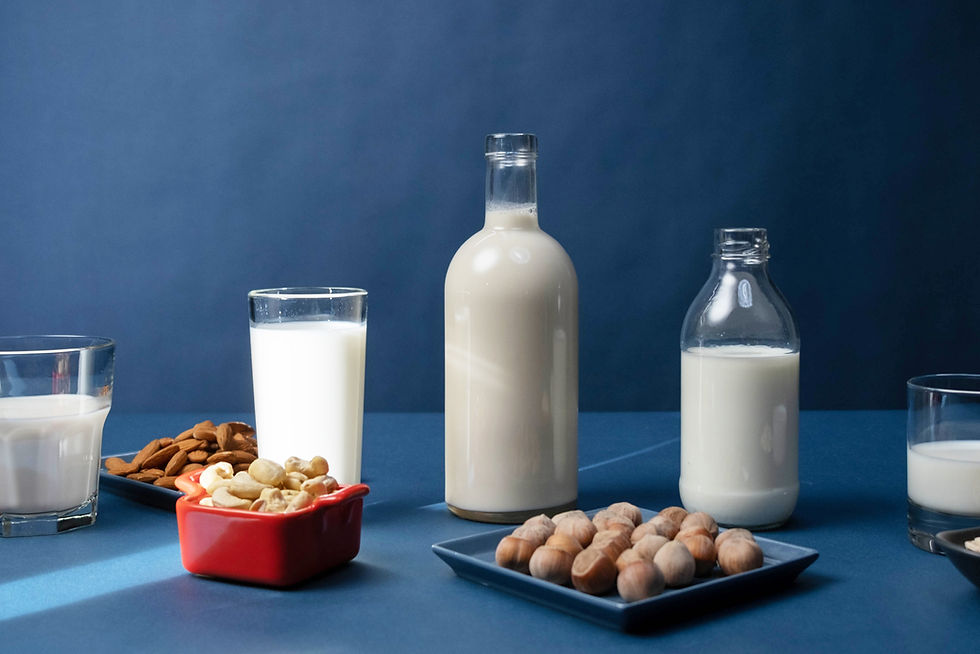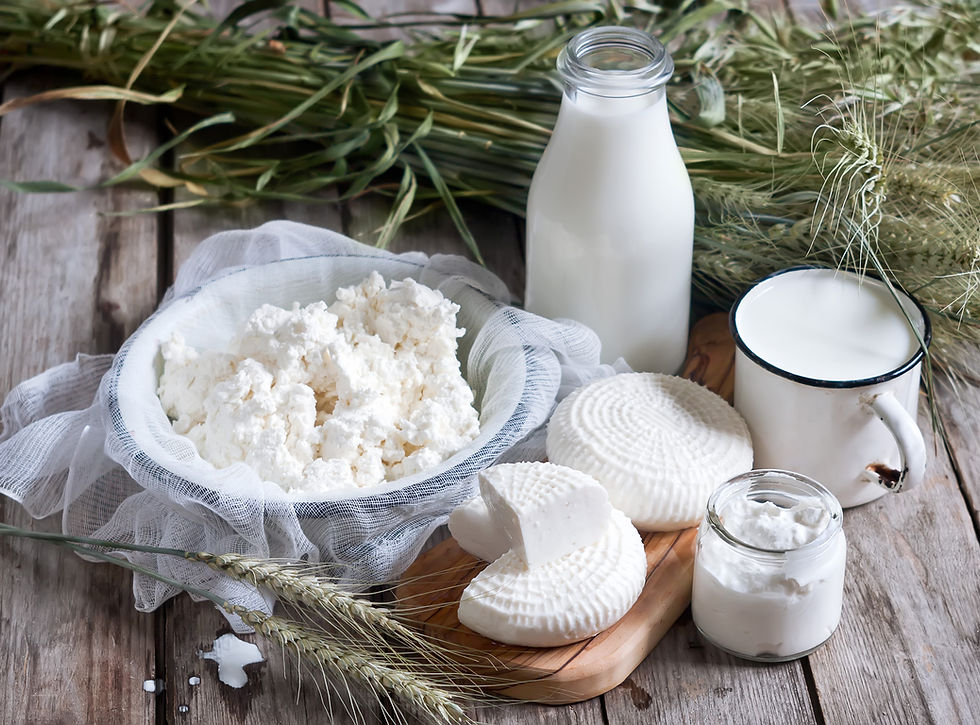Detox Your Kitchen: 11 Foods to Make or Source Cleanly to Avoid Xenoestrogens
- Aubrey Jenny

- Dec 9, 2024
- 4 min read
Updated: Jan 5
As you go through your health and detox journey, I'm sure you've heard about chemicals and compounds that are hormone disruptors or mimickers. These compounds disrupt your body's natural hormonal balance, causing menstrual irregularities, infertility, gynecomastia (man boobs), cancer, arthritis, acne, and rosacea, among other conditions. Xenoestrogens—chemicals that mimic estrogen—are particularly problematic, and avoiding them wherever possible is essential to reducing your toxic load. To better understand how these disruptors operate and the various names under which they hide, please check out my article called Understanding Xenoestrogens: The Hidden Hormone Disruptor. Due to the prevalence of these toxic chemicals in commercially manufactured products, it is best to avoid or make certain things from home to provide your body with the cleanest ingredients.
Before we begin going through these Eleven Foods:
Note: *A critical point to remember is that meat, dairy, and all animal-based products inherently contain estrogen contaminants (xenoestrogens). These are natural hormones produced by the animal, xenoestrogens compounded and absorbed from all animals they might have eaten, combined with synthetic hormones often given to animals to increase production. Once ingested, these compounds invade your body, acting as intruders rather than bioavailable nutrients. Their presence disrupts your hormonal balance, which is why transitioning to a plant-based diet—focused on minimally processed, whole foods—is strongly recommended (Smith et al., 2021).
Now, let’s examine specific foods that are particularly high in xenoestrogens and explore how to avoid or replace them for a cleaner kitchen.

1. Tofu
Why It’s Not Clean:
Tofu, made from conventionally grown soybeans, is contaminated with glyphosate, a pesticide that disrupts the endocrine system. Additionally, many tofu products include microplastics to enhance texture and creaminess, further contributing to toxicity.
At-Home Alternative:
Make your own tofu using organic, non-GMO soybeans and natural coagulants like lemon juice or magnesium chloride (nigari). Homemade tofu ensures a clean product free from pesticides and microplastics.

2. Dairy and Non-Dairy Milk
Why They’re Not Clean:
- Dairy Milk: Conventional dairy milk contains synthetic hormones (like rBGH) and pesticide residues from contaminated feed. These compounds, alongside naturally occurring animal estrogen, act as hormone disruptors when consumed. Microplastics are then added to meat in packages for color and shelf life preservation.
- Non-Dairy Milk: Store-bought plant-based milks often include microplastics for texture, emulsifiers, and preservatives like carrageenan, all of which mimic estrogen.
At-Home Alternative:
- For dairy milk, consider eliminating it from your diet entirely or sourcing raw, organic, grass-fed milk (if legal in your area).
- For plant-based milk, make your own almond, oat, or cashew milk using organic ingredients and filtered water.

3. Meat and Plant-Based Meat Alternatives
Why They’re Not Clean:
- Meat: Conventional meat is contaminated with synthetic hormones, pesticide-laden feed, and antibiotics, all of which increase xenoestrogenic load.
- Plant-Based Meat Alternatives: Highly processed alternatives often include soy protein isolates, seed oils, and microplastics, which act as endocrine disruptors.
At-Home Alternative:
- Transition to plant-based eating by crafting veggie patties with whole foods like lentils, chickpeas, or organic vegetables. For those consuming meat, source organic, grass-fed, and pasture-raised options.

4. All Dairy Products (and Alternatives)
Why They’re Not Clean:
Cheese, yogurt, and other dairy products inherit the same hormone contamination as milk. Additionally, plant-based dairy products often include synthetic stabilizers, microplastics, and xenoestrogenic oils.
At-Home Alternative:
- Make your own cashew cheese, almond yogurt, or coconut milk yogurt using clean, organic ingredients and probiotics.
- If consuming dairy, ensure it is organic and grass-fed, though avoidance is preferable.

5. Popcorn
Why It’s Not Clean:
Microwave popcorn bags are coated with perfluorinated chemicals (PFCs), and the butter flavoring includes chemicals like diacetyl. Popcorn kernels themselves may be contaminated with pesticides and microplastics from processing.
At-Home Alternative:
Pop organic popcorn kernels on the stovetop using healthy oils like coconut or avocado oil. Use real butter or natural seasonings for a safe and flavorful snack.

6. Bread and Baked Goods
Why They’re Not Clean:
Store-bought bread often contains brominated flour, preservatives, and emulsifiers that act as xenoestrogens. Many baked goods also include seed oils and microplastics for improved texture.
At-Home Alternative:
Bake your own bread with organic, unbromated flours. Try sourdough fermentation for added digestibility and nutrient benefits.

7. Soups
Why They’re Not Clean:
Canned soups contain BPA from the lining and frequently include MSG and preservatives that disrupt hormones. Soups made for creaminess often have added microplastics to improve texture.
At-Home Alternative:
Prepare soups from scratch with organic vegetables, homemade stock, and clean spices. Freeze in glass containers for quick, safe meals.

8. Honey
Why It’s Not Clean:
Commercial honey is often adulterated with corn syrup and contaminated with pesticide residues. Pasteurization destroys beneficial enzymes and nutrients.
At-Home Alternative:
Source raw, organic honey from local beekeepers who follow natural practices.

9. Cooking Oils
Why They’re Not Clean:
Refined vegetable oils like canola, soy, and corn are chemically processed and high in omega-6 fatty acids, which disrupt hormone function. These oils may also include microplastics for texture stabilization.
At-Home Alternative:
Use cold-pressed, organic oils like olive oil, avocado oil, or coconut oil. Always store oils in dark glass bottles to prevent oxidation.

10. Water
Why It’s Not Clean:
Tap water contains hormone-disrupting chemicals like atrazine, pharmaceuticals, and microplastics that accumulate during water treatment and piping.
At-Home Alternative:
Invest in a high-quality water filtration system, such as reverse osmosis, to remove contaminants effectively. To learn more about why this matters or what could be in your water read my blog about water filtration.

11.Produce
Why It’s Not Clean:
Non-organic fruits and vegetables are sprayed with pesticides like organophosphates and neonicotinoids, known endocrine disruptors. Microplastics from soil contamination can also be present.
At-Home Alternative:
Buy organic produce whenever possible. Wash all fruits and vegetables with a vinegar or baking soda solution to reduce surface residues.
While it's impossible to eliminate xenoestrogens from your life completely, reducing exposure significantly lowers your risk of hormone-related health issues. Transitioning to plant-based eating, sourcing organic ingredients, and making more foods yourself are powerful steps toward a cleaner, healthier life.
Ready to detox your kitchen? Begin with one change at a time, and don’t forget to read my article Understanding Xenoestrogens: The Hidden Hormone Disruptor for a deeper dive into what to avoid and why.
References
Smith, J., Brown, L., & Green, P. (2021). Dietary estrogens and their effects on endocrine health: A comprehensive review. Journal of Nutrition and Endocrinology, 32(4), 456-473.



Very helpful!